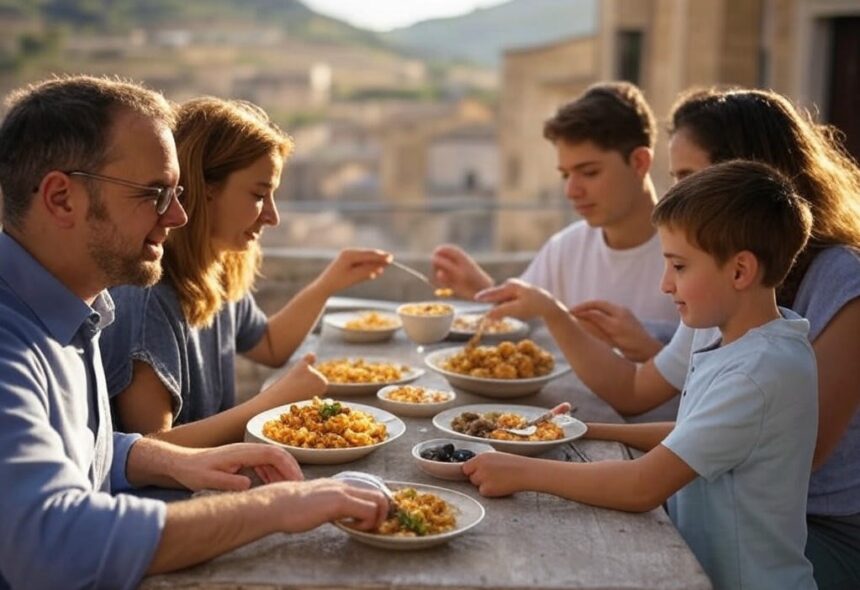Sicily, the largest island in the Mediterranean, is more than just a geographical entity—it’s a land full of vibrant cultures, deep-rooted traditions, and an unmistakable lifestyle. From its sunny beaches to its towering mountains, from its bustling cities to its quiet, picturesque villages, Sicily offers a lifestyle that’s as diverse as its landscapes. Whether it’s the food, the festivals, or the daily rituals, Sicilian life is a testament to the island’s rich history, diverse cultural influences, and the strong sense of family and community that binds it all together.
The Heart of Sicilian Life
Sicilian lifestyle is shaped by its geography, rich history, and cultural influences. It offers a combination of urban sophistication and rural simplicity, giving life a unique charm that is deeply rooted in tradition. The island’s geographic location—strategically positioned between Europe and Africa—has made it a crossroads for many civilizations, each leaving its mark on the island’s way of life. From the Greeks and Romans to the Arabs and Normans, Sicily’s cultural influences are reflected in its architecture, cuisine, and daily routines.
Geography: How Landscape Shapes Lifestyle
Sicily’s diverse landscapes have a big impact on how people live and work. The island is divided into various regions that offer a different experience depending on where you are.
- Coastal Areas: The coastal regions are characterized by beautiful beaches, cliffs, and crystal-clear waters. Fishing, seafood cuisine, and tourism are key elements of coastal life. Coastal cities like Palermo, Catania, and Trapani bustle with activity, from seafood markets to cultural events. The coast’s rich history is also evident in the numerous ancient ruins and historical landmarks that line the shore.
- Inland Areas: The inland areas, such as the hills around Caltanissetta and Enna, are home to many of Sicily’s agricultural traditions. The region’s fertile soil produces a range of crops, including citrus fruits, olives, and grapes. These regions are quieter and less commercialized, with families often engaged in farming, artisan work, and maintaining a slower pace of life.
This geographical division influences much of the lifestyle and cultural expression found on the island.
Festivals: Celebrating Culture and Religion
Festivals are central to the Sicilian lifestyle, reflecting a mix of religious devotion and cultural traditions. They are more than just celebrations; they are a time for communities to come together, express their identity, and showcase their cultural pride.
Major Festivals
- Festa di Santa Rosalia: A massive religious celebration held annually in Palermo in honor of the city’s patron saint. The festival includes processions, fireworks, and religious ceremonies that bring the entire community together.
- Festa di Sant’Agata: The grandest festival in Catania, held in February, honors Saint Agatha, the city’s patroness. This event, which spans several days, features processions, elaborate displays, and deep religious devotion, with thousands of locals participating.
Secular Traditions
- Infiorata di Noto: A stunning flower festival held in Noto each May. During this event, the streets are adorned with intricate flower carpets, drawing tourists from around the world to admire the beautiful floral designs.
- Almond Blossom Festival: Celebrating the arrival of spring, the Almond Blossom Festival takes place in Agrigento every February and marks the start of the almond harvest. The festival features parades, music, and dancing that celebrate both the natural beauty of the island and the hard work of its agricultural workers.
Family: The Core of Sicilian Society
In Sicily, family is not just a part of life—it is the cornerstone of it. The strong familial bonds that are characteristic of Sicilian life are deeply ingrained in the culture and are often expressed through shared meals, holidays, and communal activities.
Multigenerational Living
- Families often live together in multigenerational households. It is not uncommon for grandparents, parents, and children to share the same home, with the older generation playing an essential role in raising children and passing down traditions. This lifestyle reinforces the values of respect for elders and the importance of family unity.
Strong Community Ties
- La Passeggiata: A daily social walk that takes place in the evening, where families and friends gather to stroll through town centers and socialize. It’s not just about walking; it’s about connecting with others and enjoying the sense of community.
- Shared Meals: Food is an integral part of family life. Meals are typically long, social events that allow families to bond. The tradition of cooking and dining together remains central to Sicilian life, with dishes often passed down through generations.
The Sicilian Diet: A Celebration of Food
The Sicilian diet is a reflection of the island’s history, climate, and multicultural influences. It’s a cuisine that focuses on fresh, local ingredients, and the meals are designed to be shared among family and friends.
Traditional Dishes
- Arancini: Fried rice balls filled with meat, cheese, or vegetables. These are a staple in Sicilian cuisine, typically eaten as a snack or part of a meal.
- Caponata: A traditional eggplant dish that is made with tomatoes, onions, olives, and capers, often served as a side dish. The combination of sweet and sour flavors is a hallmark of Sicilian cooking.
Coffee Rituals
- Caffè Freddo: An iced coffee enjoyed especially during the hot summer months. It’s made with espresso and sugar, then chilled for a refreshing experience.
- Caffè Corretto: A beloved Sicilian drink, this espresso is “corrected” with a splash of liquor, such as grappa or sambuca, providing a warming and bold flavor.
Arts and Crafts: Preserving Tradition
Sicilian craftsmanship is an art form in itself, with centuries-old techniques still used by local artisans to create everything from ceramics to textiles.
Handicrafts
- Ceramics: The island’s ceramics are famous for their vibrant colors and intricate designs. These handmade pieces often feature motifs of nature, religion, and Sicily’s cultural heritage. They can be found in many local homes, as well as sold in markets across the island.
- Textiles: Handwoven fabrics are still created in traditional methods in Sicily, especially in rural areas. These textiles are used to create everything from clothing to home décor.
Music and Dance
- Folk Music: Music is an essential part of Sicilian culture. The island has its own unique musical style, with instruments like the mandolin and tambourine playing an important role in traditional performances.
- Ballo della Cordella: A folk dance performed during festivals in Petralia Sottana and other parts of Sicily. The dance is accompanied by lively music and is a visual expression of community celebration.
Daily Life: Simplicity and Gratitude
Sicilian life, especially in the rural areas, is known for its slower pace. Life is about savoring each moment and appreciating the simplicity of the daily routine.
A Slower Pace of Life
Unlike the fast-paced lifestyles found in many parts of the world, the rhythm of life in Sicily is slower and more deliberate. While urban centers can be hectic, the rural areas of Sicily emphasize relaxation and family time. Even in the cities, the idea of enjoying time and being present is highly valued.
Value of Time
Time in Sicily is often viewed differently. It’s about living in the moment, enjoying long meals, and connecting with loved ones. Work and responsibilities exist, but they don’t dominate life. The focus is on maintaining balance and savoring the small pleasures of everyday existence.
Fashion: The Blend of Tradition and Modernity
Sicilian fashion is a reflection of the island’s cultural richness, blending traditional influences with modern trends.
Traditional Sicilian Fashion
In rural areas, traditional clothing still plays a role during festivals and holidays. Brightly colored dresses for women and tailored suits for men are common during celebrations, reflecting both the island’s Mediterranean warmth and its vibrant cultural identity.
Modern Influence
Fashion in Sicily has also embraced modern trends, with global designers like Dolce & Gabbana drawing inspiration from the island’s unique traditions. The combination of contemporary fashion with traditional Sicilian elements has led to a fusion that is both stylish and authentic.
Sicily’s Influence on Global Culture
Sicilian culture has had a far-reaching impact on the world, influencing various aspects of global culture, from food to fashion to cinema.
Culinary Influence
Sicily’s cuisine, especially its use of fresh seafood, citrus fruits, and unique pastries, has become internationally beloved. Dishes like cannoli and pasta alla Norma are now enjoyed around the world.
Cinema and Arts
Sicily has also left its mark on cinema. Films like The Godfather have immortalized the island’s landscapes, culture, and people, shaping global perceptions of Sicilian life and heritage.
Conclusion:
The Sicilian lifestyle is an embodiment of cultural richness, history, and community. From vibrant festivals to a deep connection to family and the land, it offers a slower-paced yet fulfilling way of life that has endured for centuries. Whether you live in Sicily or are just visiting, embracing its way of life means connecting with its traditions, enjoying the simple pleasures of daily moments, and celebrating the values that make this island so unique.






